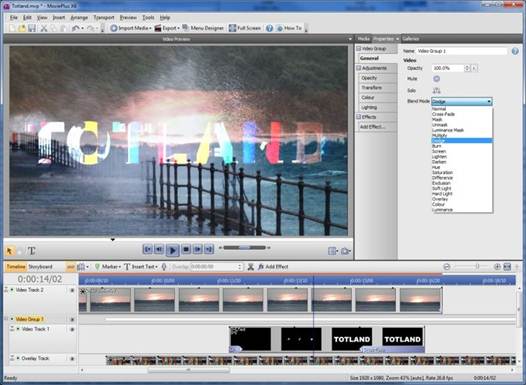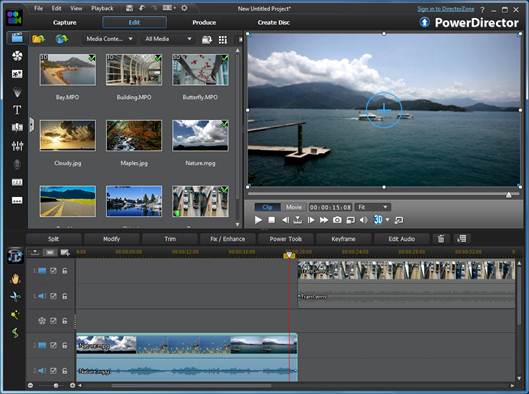Price: $117
Website: www.adobe.com
Adobe Premiere Elements on our Bronze Award
last year, but it’s since been overhauled with a great-looking new interface.
We found the new software to be faster and easier to use than last year’s
version. It’s enough to push last year’s winner, Serif MoviePlus, into second
place.
The Quick and Expert editing tools now have
their own tabs. Quick is aimed at beginners, and is useful if you only want to
make simple changes to a video. For more precise changes, click Expert and your
video and its edits will copy over to the new tab automatically and
instantaneously.
The new Action bar, which contains all the
editing tools you need, sits below the timeline on both tabs. Common
adjustments and effects can be found in the right-hand panel in clearly
defined, resizable menus. Other windows, including the preview pane and
timeline, can also be resized, and extra panes, including an Audio Mixer and
History, can be added.

We
found the new software to be faster and easier to use than last year’s version
The History window lets you roll back your
video to a previous point, keep track of edits and quickly undo mistakes. It’s
a small but indispensable editing feature. Other touches that speed up your
editing include placing the Render button above the timeline, so you can carry
out this processor-intensive task and create final versions of edits when it’s
convenient; and locating the Scissor icon, which splits the clip with a single
click, on the timeline marker. These customization options set Premiere
Elements above the Silver and Bronze winners.
There’s a wide selection of titles and
credits available, and graphics are sharper than in other programs. Edits and
transitions are slick and professional looking, and our finished movie was only
bettered in quality by Sony’s sharper; brighter video.
Premiere Elements was the fastest software
we used; it imported our video file, music track, and photo within six seconds,
and exported it in 1 minute 58 seconds.
Verdict
Premiere Elements ran away with the Gold
Award because it excelled in every category. This latest version is a vast
improvement on last year’s: it’s easier to use and quick to master, making it
perfect for beginners, but it also has enough advanced tools to satisfy
experts. Premiere Elements only comes in one version with one price, so it’s
more suited to advanced users who will benefit from all its tools and effects.
However, we think it’s worth the extra money for such great performance and
professional-looking result.
Serif MoviePlus X6
Price: $69
Website: www.serif.com
There isn’t much too separate Serif’s
video-editing software from Adobe’s. Their colour schemes, layouts, edits,
transitions and export options are almost identical. There was no slow-down
during playback or previewing on either software, on both HD and SD (standard
definition) files, and both came within seconds of each other when importing
and exporting files.
The decision to give Serif the Silver Award
came down to the quality of our finished video, particularly the edits and
effects. Transitions aren’t as smooth in MoviePlus, colour effects are washed
out, some filter effects look less professional and graphics aren’t as sharp.

Also, MoviePlus is harder to use than
Premiere Elements. The snapping tool isn’t as accurate, so we kept accidentally
leaving gaps and overlapping clips, and there’s no option to delete gaps
between clips when you remove a section of video. Waveforms aren’t generated
automatically on audio tracks, and you can’t customize your workspace as
extensively. Also, effects and adjustments are kept under Properties, while
transitions are under Galleries, rather than both being accessible from a
single place. Even the menu labels aren’t as clear as those in Premiere
Elements.
However, the most popular tools are all
within easy reach and Serif’s many shortcuts are easier to master than any
other software – S for Split, M for Mute, Delete to remove clips and the
spacebar to play. You can render effect on individual clips by clicking a red
bar above each one, or the whole video using the Enter key. While other
software, including our Bronze winner PowerDirector, suffered poor playback
until you rendered the clips, MoviePlus’s playback quality was barely affected,
meaning Serif’s background rendering performs much better.
Verdict
MoviePlus is almost half the price of
Premiere Elements, but Serif hasn’t scrimped on the amount of features you get.
Its performance impressed us and gave more expensive products a run for their
money, though it couldn’t live up to the very high standard set by Adobe.
Still, MoviePlus gets our Sliver Award for being a great all-round product,
suitable both for beginners and advanced users, as well as being outstanding
value for money.
CyberLink PowerDirector Ultimate
Price: $150
Website: www.cyberlink.com
CyberLink has added some useful new
features to PowerDirector, our favourite being Content Aware Editing, which
scans files for shaky camerawork, poor audio and bad lighting, and fixes
sections individually. Although other programs have similar automatic-editing
tools, CyberLink’s is the most precise and produces the best results.

CyberLink
has added some useful new features to PowerDirector
The new Design Studio is also a leap
forward, offering precise edits to shadows, reflections and borders, and adding
masks and motion tracking. You can also preview clips and music within the Open
dialogue box when you import files into PowerDirector, to check that you’re
choosing the correct one.
The number of built-in edits, transitions
and effects matches those available on MoviePlus and Premiere Elements.
However, you can download more from CyberLink’s online DirectorZone.
As with Premiere Elements and MoviePlus,
all PowerDirector’s tools are within easy reach, although the labels aren’t as
clear as in Premiere Elements, and we’d prefer the Import button to be more
prominent. PowerDirector isn’t as customizable as Premiere Elements, but you
can undock the preview window, which makes it more flexible than MoviePlus.
It also isn’t as fast. It opened quickly,
but pre-rendering is turned on by default and we often had to wait for clips to
render before we could continue. Playback was sometimes jerky and exporting
took three minutes 45 seconds. Many of the niggles we didn’t like last year
have remained, too. You still have to switch between editing modes if you want
to make changes to the video or an individual clip, and stock photos and audio
still clutter your library.
Verdict
PowerDirector has made some leaps since we
reviewed it last year. It’s now easier to use and has more features, but these
improvements have been paid for with a reduction in performance. It still takes
time to get to grips with all PowerDirector’s menus and options. Which might
deter beginners, but it’s worth the effort.
PowerDirector Ultimate is one of the most
expensive products we tested, alongside Magix’s Movie Edit Pro, and although
you get more than what you pay for with its range of tools and features,
cheaper programs performed significantly better.